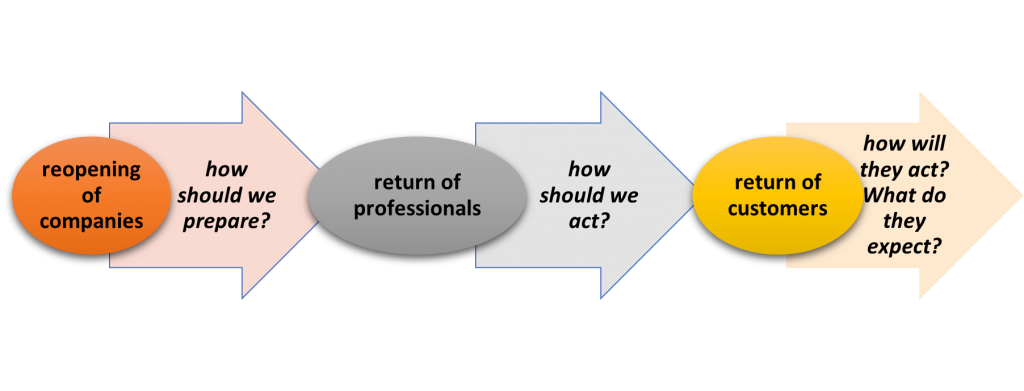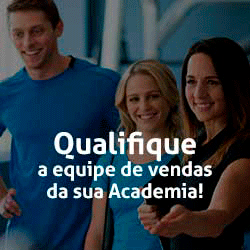Most services provided by fitness & wellness centers, had as an assumption, physical presence, direct contact and proximity between people, the only way to happen. Until very recently, specifically before the pandemic, virtual services were considered as something “strange”, “inadequate” and “incomplete”, in addition to receiving strong criticism on a technical-scientific basis, regarding the effectiveness in the results intended by its consumers.
However, the condition of home confinement and social distance, which were not choices, but needs that were identified worldwide as a way of preserving lives, directly impacted fitness & wellness centers, leading to sudden closure and, consequently, to a radical change in the way these customers consume services in these companies and their relationship.
In this context, and with the progress towards the control of COVID-19, the return to consumption in the face-to-face format, although surrounded by restrictions and security measures, demands a reorganization of the logistics and hygiene of these companies. In addition, new practices, habits, and attitudes from all stakeholders involved in this consumption relationship are necessary, although many have not even been imagined before, sometimes even denying assumptions that were common sense in these centers.
In addition to meeting a relevant set of health requirements, all companies that return to their activities need to realize that the returning customer is no longer the same, as it has been compulsorily modified in their beliefs, convictions and perceptions with regard to their own lives and for this very reason, understanding these “new” demands in great detail means not only learning to live a “new normal”, an excessively simplifying expression, in our view, and which does not account for the complexity experienced.
We are facing a new scenario, a new reality, which seems more explainable when associated with the VUCA the acronym of the words Volatility, Uncertainty, Complexity and Ambiguity, created by the US Army War College in the 90s to explain the characteristics of the world in the post-Cold War context, a reality, in some respects, similar to what we live in now.
In this context, we consider it essential that professionals working in the fitness & wellness companies take into account that the return of activities in these companies will take the form of a process, that is, in a temporal sequence with different characteristics and that demand specific inquiries by their actors, as shown below:

This process therefore considers the involvement of different stakeholders in the production of deliveries that the company proposes to make. From this point of view, it is relevant to consider that the participation and importance of all these actors is aligned, and considers the theory of stakeholders as a conceptual basis (FREEMAN, 1984) when he proposes that business should bring benefits to all those directly/indirectly involved in their production, considering that they play distinct but equally relevant roles in the final result (DUFRENE; WONG, 1996).
This conceptual model is opposed, and seeks to overcome the theory of shareholders (FRIEDMAN, 1962), which proposed a focus only on the owners/shareholders of organizations as the direction and purpose of managerial actions and, therefore, concerns with respect to impacts results produced.
In view of this context, an unusual “restart” of consumption, of services in the fitness & wellness centers, an opinion survey was carried out, as from the 2nd week of social isolation formally decided by government agencies, in which the closing of these companies was inserted.
For this purpose, adults of both sexes, regular clients of fitness & wellness centers were consulted regardless of age, time of practice, type of modality practiced and objectives of this practice.
The respondents, in order that their responses were considered valid, should declare, a priori, the intention to return their practices in the places where they trained before the closure generated by the pandemic. Electronic (virtual) channels were used to collect data, seeking answers to a single question:
“What do you expect to find on returning to the fitness center where you trained before the pandemic?”
From July to August/2020, a total of 421 people voluntarily responded the electronic form, built from Google Formsä, and sent as a link to 500 people who were part of diversified distribution lists in relationship apps.
Then, through the analysis of the collected data, responses were grouped into dimensions, using the criteria of similarity (synonymous expressions) and exclusivity (not belonging to more than one dimension). Thus, responses were grouped into 5 dimensions, described in Table 1, expressing different types of expectations in the post-pandemic return of consumers of fitness & wellness services in the city of Rio de Janeiro, Brazil.
Table 1 – Dimensions of the framework of consumer responses
(1) Training environment à aspects linked to the physical and structural spaces of the center.
(2) Relations with People Who Work à aspects related to interpersonal relationships.
(3) Objective Delivery – Practiced Activities à aspects related to the services consumed.
(4) Benefit-Cost Ratio à aspects related to prices paid, added value and guarantees.
(5) News and Innovations à aspects related to the delivery of improvements and / or new products.
Source: the research
1. Training environment
In this dimension, we can call “careful” THE keyword, for it had a high incidence in the answers, that is, in different ways of expressing, people declared expectations regarding the need to feel “cared” in terms of preservation of health, both by the people with whom they deal directly and by the company and its structures. This care represents the concern with the existence of an aseptic, sanitized environment and with resources and materials for everyone to use, which provide the removal, or minimization, of the risk of contamination.
In addition, another relevant factor highlighted by the respondents was protection, translated both by availability, as well as using personal protective equipment (masks and gloves). Finally, in relation to the environment of the physical training centers, and declared by almost all respondents, was the layout of the spaces for the practices.
This aspect, linked to the recommended areas of circulation and safe distance, accounts for the guarantee that they will resume their exercise practices without the risk of physical contact with others who were training there.
2. Relations with People Who Work
In this dimension, centered eminently on people and their interactions, the feelings and expectations declared by consumers refer not only to the interaction between customers and service providers, but also those established between customers-customers. All of them can be represented by the expression “reception”.
We can say that this reception can be translated by the expectations of the clients to find in the professionals: full and sincere availability to serve them, kindness and courtesy in this service, full attention to their reactions to a new context of exercise practices, interaction, since the quarantine period made them isolated in their homes, as well as confidence in the relationships and the possibility of being able to recover the normality and the gains that the exercises provided, but were interrupted by the pandemic.
3. Objective Delivery: Practiced Activities
This concept represents the moment of truth in the provision of services, that is, the direct relationship in which the professional takes his client to experience the service itself in a concrete, objective way.
In this context, consumers report expectations that are linked primarily to an “wow” experience, exceptional, capable of overcoming what they expect, a fact that can be explained by the demand that a confinement creates for experiences other than the routine.
In addition, consumers of these services expressed expectations for the adequacy between the proposed activities, the moment they lived and the conditions in which they find themselves, that is, stressed with this whole situation. They also report expecting motivational actions, in the sense of feeling encouraged to overcome limitations imposed by the withdrawal from the practice, which, therefore, creates the desire to achieve progressively better results.
4. Benefit-Cost Ratio
In this dimension, responses linked to an expectation of cost revision by companies were grouped, given the still weak economic scenario in the country because of the pandemic, thus impacting prices more adjusted to this reality.
In addition, they also expect to be offered plans that are more in line with their actual consumption realities in terms of varieties.
Finally, and as a surprise derived from the context itself, the expectation of guarantees for reimbursement or prevention of financial losses was recorded, in the event of any other interruption in the offer of services by the companies of which they are clients.
5. News and innovations
In this dimension, responses linked to the expectation of receiving changes in content and form in the services they already used were grouped, such as different class methodologies, diversified material resources, alternate use of machines and their own body weight, alternation of rhythms and training environments, that is, something that makes delivery different from what happened before the pandemic.
In addition, a highly relevant point, derived from the “forced entry” of “digital technology” into the fitness & wellness environment, was the expectation of customers for increases in the ways in which services were delivered, with numerous textual statements to expect the gym/studio offer plans with options to train online too or instead of face-to-face, thus demonstrating that virtual classes, the only option available in the pandemic due to the circumstances, occupied an opportunity gap in service delivery strategies and attracted people to their consumption as a possibility to take care of your health.
Finally, and considering that these results express a snapshot of reality, due to their sample characteristics, we still suggest that they be considered, at least, as a basis for reflections and discussions of managers with their teams about this new reality, which their companies will start to incorporate into their businesses, not by choice, but by necessity, as the consumer has definitely changed.
With this, we propose to both managers and professionals to review and, if necessary, adjust their conducts, spaces and attitudes at a time when consumers and service providers are building, elaborating, redesigning their consumer relations, in addition to technical issues.
In summary, we understand that, more than ever, we need to become “relevant”, “essential” for these clients if we really want to be perceived as providers of the improvement in the quality of their lives.
This means that, in order to be relevant, it is often necessary to review the very reason for being and your purpose, as we live in this post-pandemic context a moment of great learning, in which the metaphor created by the Bridge of Choluteca in Honduras, in Central America, its initial purposes and its condition nowadays offers us as a teaching the need to change the traditional paradigm about our companies, which until today followed the premise of needing to be “made to last” in order, perhaps, to assume the condition to be “made to adapt”, or, instead of considering strategic the search for different solutions to the same problem, think that problems can change and, therefore, the mental model used to solve them may no longer be suitable for the new scenario.
This is, in the final analysis, the challenge that the pandemic brings us as an opportunity, alongside all the inherent risks.
References
DUFRENE, Uric; WONG, Alan. Stakeholders versus Stockholders and Financial Ethics: ethics to whom? Managerial Finance. Patrington, v.22, n.4, p.1-11, 1996.
FREEMAN, R. Edward. Strategic management: a stakeholder approach. Boston: Pitman, 1984.
FRIEDMAN, Milton. Capitalism and freedom. 2nd. ed. Chicago: University of Chicago Press, 1962




